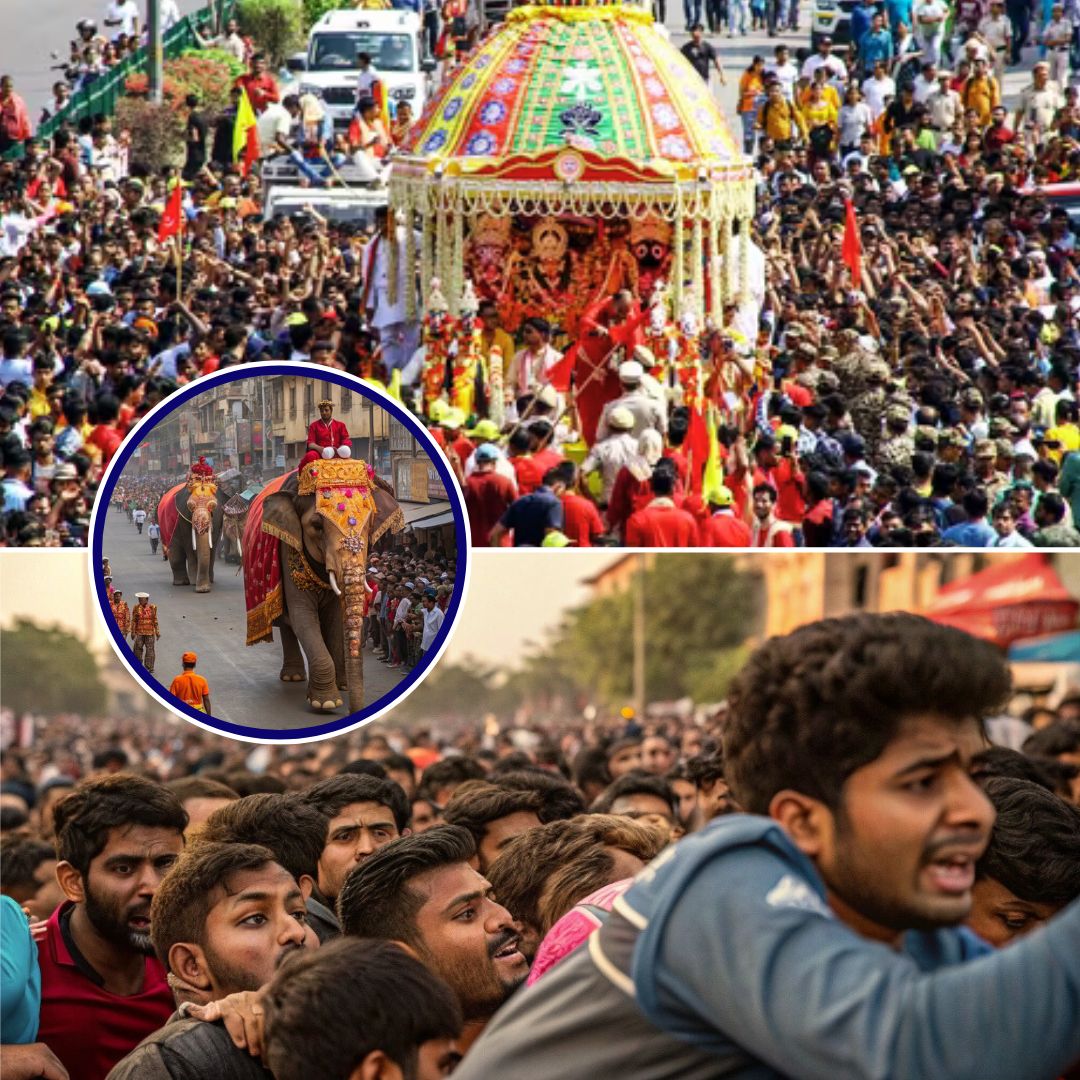A major scare unfolded during Ahmedabad’s 148th Jagannath Rath Yatra on Friday morning when three elephants, including the only male in the procession, lost control in the crowded Khadia area.
The chaos, reportedly triggered by loud music and whistles, led to panic and a brief stampede, resulting in at least three injuries. Swift intervention by zoo officials, mahouts, police, and the forest department brought the situation under control.
The agitated elephants were tranquilised and removed from the yatra, while authorities banned DJ music along the route and ensured the procession continued safely with the remaining elephants.
Chaos in Khadia: How the Incident Unfolded
The Rath Yatra, a centuries-old festival that draws lakhs of devotees, began smoothly from the historic Jagannath Temple. However, as the procession entered the densely populated Khadia locality around 9:30 AM, the only male elephant in the group of 18 became visibly agitated.
Eyewitnesses reported that the animal, startled by blaring DJ music and the sound of whistles, suddenly broke away from its handlers and charged into a narrow lane filled with devotees. “There was a sudden commotion. People started running in every direction as the elephant came towards us. Some even fell in the rush,” said a local resident.
The mahavat (elephant handler) acted quickly, jumping off the elephant and running to help subdue it. Two female elephants were then brought in to help calm the male, following established safety procedures.
Zoo officials and forest department staff, already deployed along the route, administered a tranquiliser injection to the agitated elephant. In the confusion, two more elephants also became restless and broke formation, adding to the panic.
Police and organisers responded by clearing the area and guiding the crowd to safety. Among the injured were a woman police constable, a TV cameraman, and a devotee, all of whom received prompt medical attention. Fortunately, no fatalities were reported.
Safety Protocols, Official Reactions & Ongoing Investigation
Authorities responded with urgency to prevent escalation. Police Commissioner GS Malik confirmed, “The situation was brought under control within minutes due to the coordinated efforts of the police, forest officials, and zoo staff.
The three elephants were tranquilised and removed from the procession for everyone’s safety.” The remaining 15 elephants continued leading the chariots, and the yatra resumed its route without further incident.
In the aftermath, the Ahmedabad Police immediately banned the use of DJ music and loudspeakers for the rest of the yatra to prevent further distress to animals. Organisers were instructed to ensure all music vehicles and trucks remained silent.
The forest department has launched an inquiry to determine the exact cause of the elephants’ agitation, with initial findings pointing to noise-related stress. The elephants are currently under veterinary observation and will not rejoin the yatra.
Meanwhile, security has been heightened, with over 23,000 police personnel, 41 drones, and AI-powered surveillance cameras monitoring the event to ensure public safety.
Tradition, Animal Welfare, and the Way Forward
The Jagannath Rath Yatra is the second-largest chariot festival in India, after Puri, and is renowned for its elaborate rituals, decorated elephants, and massive turnout. This year’s incident is unprecedented in the event’s 148-year history.
In recent years, concerns about animal welfare have grown, with animal rights groups urging organisers to reconsider the use of elephants and other animals in large, noisy public gatherings.
Officials have promised a thorough review of current safety protocols and are considering new guidelines to better protect both animals and people during future festivals.
The Logical Indian’s Perspective
This incident is a stark reminder of the need to balance cherished traditions with compassion and responsibility. The swift, coordinated response by authorities undoubtedly prevented a greater tragedy, but it also highlights the vulnerability of animals subjected to stressful environments for human celebration.
As a society, we must reflect on how we can honour our heritage while evolving our practices to ensure the wellbeing of all living beings. Can we imagine a future where our festivals are celebrated with equal joy, but with greater empathy and safety for both people and animals?











